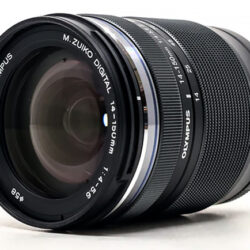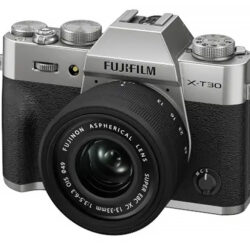In our second market survey we list the best, mainly mirrorless, camera kits currently available for weight-conscious travellers and everyday users.
While a smartphone is the camera you always have with you, an interchangeable-lens camera should produce better-looking images is a wider range of situations. Much more versatile than either fixed-lens cameras or smartphones because they accept a wide variety of lenses, they also give you a sense of creative engagement with the end result.

Interchangeable-lens cameras give you a sense of creative engagement with the shots you take. (Image by Chris Poplawski, sourced from OM Digital Solutions.)
In the last five years the interchangeable-lens camera market has shifted from DSLR to mirrorless designs – and camera buyers have benefited. Mirrorless cameras provide better integration of stills and video functions, making them equally capable of shooting stills and video. Today, only Pentax continues to produce DSLR cameras, and they have one model in this survey.
Canon EOS R100 (May 2023)

Canon’s lightweight (356 grams) entry-level camera has an unstabilised, APS-C (22.3 x 14.9mm) 24-megapixel CMOS sensor and DIGIC 8 processor. Its user interface provides the standard P/A/S/M settings as well as automatic shooting modes like Creative Assist and Creative Filters. The Hybrid CD/PD AF system uses 143 focus points and includes face detection and tracking. The camera supports JPEG, HEIF and RAW file recording with continuous shooting at up to 6.5 fps. Movie Servo AF is available. Video can be recorded at 4K 30p resolution or Full HD at up to 120p. Time-lapse movies are supported.
The EVF has 2,360,000 dots and the fixed, 3-inch LCD monitor has a resolution of 1,040,000 dots but is not touch enabled. Image and video data are recorded on a single UHS-I SD card and the battery capacity is 430 frames/charge when the monitor is used for framing or 340 frames/charge with the EVF. The camera comes with a built-in GN 6.0 flash, a USB-C port and a microphone in terminal. Wi-Fi and Bluetooth allow uploading to social media via the Canon Connect app. The camera measures 116 x 86 x 69 mm and has an RRP of $999 when bundled with the RF-S 18-45mm f/4.5-6.3 IS STM kit lens. A twin-lens kit with the RF-S 55-210mm f/5-7.1 IS STM lens is available for $1299.
Canon EOS R10 (May 2022)

This mid-range, 24-megapixel camera has an APS-C (22.3 x 14.9mm) CMOS sensor with Dual Pixel AF that provides dedicated modes for tracking animals, people and vehicles. It features Canon’s latest DIGIC X image processor. Compact and lightweight at 426 grams, it measures 123 x 88 x 83 mm and comes with an LP-E17 battery with a capacity of 450 frames/charge. Continuous shooting can achieve a maximum speed of 15 fps with the mechanical or first-curtain electronic shutter or up to 23 fps with the electronic shutter. Users can record 10-bit HDR PQ video and HEIF photo files and 4K/30p oversampled video from the full width of the sensor or at up to 60 fps with 1.56x frame cropping. The R10 can also record Full HD video at up to 120 fps as well as FHD time-lapse movies.
New scene modes include a focus stacking mode, a panorama mode and a panning mode that automatically selects a shutter speed that will keep the subject sharp. The fully articulated, 3-inch LCD monitor has touch-screen capabilities and a resolution of 1,040,000 dots. A 2,360,000-dot EVF is also provided with a magnification of 0.95x. The single SD card slot is UHS-II compatible and the EOS R10 has a built-in flash plus Wi-Fi and Bluetooth connectivity. The EPS R10 is offered with RF-S18-45mm f/4.5-6.3 IS STM lens for an RRP of $1649 or with the RF-S18-150mm f/3.5-6.3 IS STM kit lens for $1699.
Canon EOS R50 (February 2023)
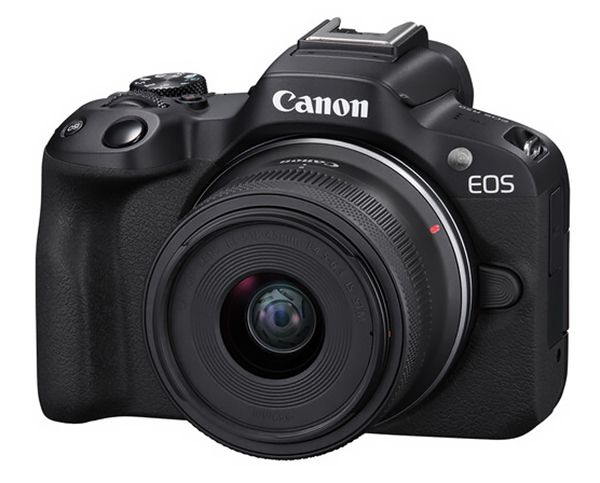
The lightweight (375 grams) EOS R50 comes with a 24.2-megapixel APS-C (22.3 x 14.9mm) CMOS sensor and DIGIC X image processor. As well as P/A/S/M settings, it provides simple automatic modes like Creative Assist, Creative Bracket and Advanced A+ for novice users, while content creators can record 4K 30p video (from 6K oversampling) and Full HD 120p slow motion videos. Vertical video and time-lapse recording are also supported. The phase-detection autofocusing system supports advanced tracking for humans, animals and vehicles and exposures automatically respond to dynamically changing scenes. Continuous shooting is available at up to 15 frames/second. The Auto Level mode ensures scenes and landscapes are recorded with straight horizons.
Dedicated vlogging modes for Close-Up Demos and Movie IS make it easy to capture usable videos for sharing via social media. Built-in Bluetooth, Wi-Fi or USB wired connections support direct uploading and sharing on social media. The R50 comes with a built-in GN 6 flash and single UHS-I SD media slot. It also has a microphone input terminal (but no headphones jack) and a LP-E17 battery with a capacity of up to 450 frames/charge. The camera body measures 116 x 86 x 69 mm. Its RRP is $1399 for the single-lens kit with the RF-S 18-45mm f/4.5-6.3 IS STM lens. It is also available as a twin lens kit with the additional RF-S 55-210mm f/5-7.1 IS STM lens for $1499.
Canon EOS R50 V (March 2025)
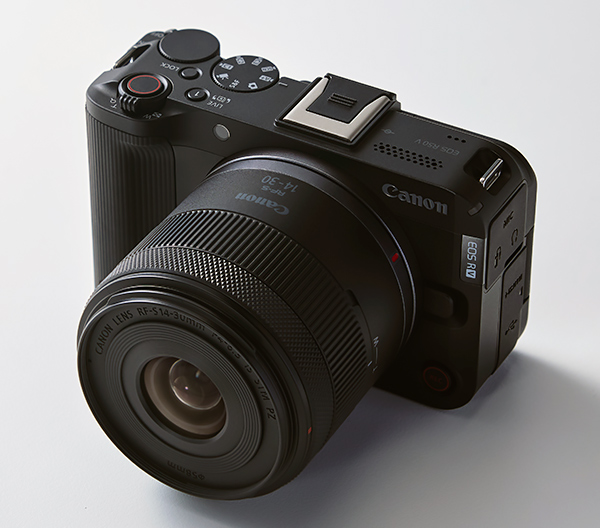
Targeted at vloggers, the EOS R50 V is smaller and lighter than the similarly-specified EOS R50 because it has no viewfinder. While featuring the same 24.2-megapixel sensor and DIGIC X processor and supporting the same image and video file formats, its user interface prioritises video over stills capture. The camera body has an extra front REC button and second tripod socket on the side panel for vertical video recording. It also comes with a built-in, three-capsule microphone, separate mic-in jack and dedicated headphone port. The only stabilisation provided is Movie IS, which involves frame cropping.
Video is always recorded in the XF-HEVC S file format with standard Long GOP compression and the camera can record oversampled 6K to 4K UHD movies at up to 30p or up to 60p with a 1.56x frame crop. Full-HD High-frame rate movies can be recorded at up to 120 fps with Dual Pixel CMOS AF tracking. A selectable Smooth Skin Movie mode is available for vlogger selfies. The R50V comes with built-in Wi-Fi and Bluetooth 5.1 connectivity as well as UVC/UAC compatibility, which supports streaming video and also allows it to act as a webcam via its HDMI port. Continuous shooting is available at up to 12 fps and the single UHS-II SD slot shares the battery compartment with the LP-E17 rechargeable battery. The EOS R50 V measures 119 x 74 x 45 mm and weighs 370 grams. Its body RRP is $1169 but the camera is also available with the RF-S 14-30mm f/4-6.3 IS STM PZ kit lens for $1499.
Fujifilm X-M5 (October 2024)
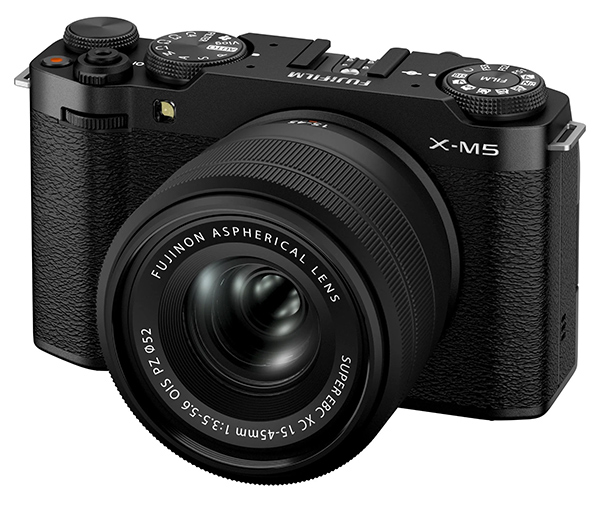
Featuring a 26-megapixel APS-C (23.5 x 15.6 mm) BSI X-Trans CMOS 4 sensor and X Processor 5 processor, the X-M5 is a compact (112 x 67 x 38 mm) and lightweight (355 grams) camera that fits into a jacket pocket and is designed mainly for vloggers. It has dial-based controls and a hybrid (CD/PD) autofocusing system with human face and eye detection plus recognition of animals, birds, cars, motorcycles, bikes, airplanes and trains. The fully-articulated 3-inch monitor has a resolution of 1,040,000 dots and is touch enabled. There is no viewfinder. Still images can be recorded as JPEGs, 4:2:2 10-bit HEIF or 14-bit RAW files, with RAW to TIFF conversion available in the camera.
Movies can be recorded to the single, UHS-I compatible SD card with 6.2K (16:9) resolution at up to 30 fps. The X-M5 also supports DCI 4K (17:9) or 4K (16:9) recording at up to 60 fps and Full HD video at up to 240 fps in High-Speed Rec. mode. In addition to F-Log, the X-M5 also supports F-Log2, which captures a dynamic range of 13+ stops. A new Short Movie mode makes it easy to create 15-60 second clips for sharing on social media. Vertical recordings can be made without having to turn the camera on its side. A special Product Priority mode prioritises the focus to make demonstrations easy. Three built-in microphones ensure superior soundtracks. Continuous shooting is available in both burst and pre-shot modes at up to 20 fps with a 1.29x frame crop. The NP-W126S battery has a capacity of 440 frames/charge. The RRP for the X-M5 body is $1449 and the camera is offered with the XC15-45mm f/3.5-5.6 OIS PZ lens for $1649.
Fujifilm X-T30 III (October 2025)

Equipped with the same 26.1-megapixel APS-C X-Trans BSI CMOS 4 sensor as its predecessor but an updated X-Processor 5 image processor, Fujifilm’s premium entry-level camera has AI AF Subject detection and can record 6.2K/30p video with 4:2:2 10-bit quality as well as 4K/60p and 1080/240p high-speed movies. A 9:16 movie mode for vertical video recording is also available while a Film Simulation dial gives users quick access to 20 Film Simulations and also provides three customisable positions (FS1 to FS3) for registering favourite ‘FS Recipes’. The pop-up flash and AUTO shooting mode switch carry over from the previous model and the new camera’s body is the same size, measuring 118.4 x 82.8 x 46.8 mm and weighing 378 grams.
The X-T30 III has a metal top-plate and control dials plus a generous grip. Its tilting touchscreen monitor has a resolution of 1,620,000 dots, while the OLED EVF has a resolution of 2,360,000 dots. A small joystick low on the rear panel makes it easy to select the focus area and navigate menus. The single UHS-I media slot is located in the battery compartment and the NP-W126 battery can support 315 shots/charge or up to 425 shots in Eco mode. The camera will be available in black, silver and charcoal silver and comes with USB-C and micro-HDMI ports and 2.5mm microphone/remote release port. The camera body will be available in late November at an RRP of $1679 and offered in kit format in December with the Fujinon CX 13-33mm f/3.506.3 OIS lens for $1949.
Fujifilm X-S20 (May 2023)

The X-S20 measures 127.7 x 85.1m x 65.4 mm, weighs 491 grams and features a large and easy-to-hold grip. Its 26-megapixel APS-C (23.5 x 15.6 mm) X-Trans CMOS 4 sensor is paired with the X Processor 5 processor. The five-axis in-body image stabilisation (IBIS) system provides up to 7 stops of shake compensation. Nineteen Film Simulation modes let users replicate the analog look of film and the high-capacity NP-W235 battery has an impressive life of up to 800 frames in economy mode. Subject-detection AF uses Deep-Learning AI Technology to identify and track human faces and eyes, animals, birds, cars, motorcycles, bicycles, airplanes, trains, insects and drones. Dedicated Auto and Vlog modes facilitate recording of videos. The X-S20 can record video with 6.2K (16:9) resolution at up to 30 fps, along with 4K in 17:9 and 16:9 formats at up to 60p. Time-lapse recording is supported.
The single SD card slot is UHS-I, UHS-II and Video Speed Class V90 compatible and the camera can record JPEGs, 4:2:2 10-bit HEIF or 14-bit RAW files, with in-camera RAW to TIFF conversion also available. Continuous shooting is supported in both burst and pre-shot modes at up to 20 fps with a 1.25x frame crop. The built-in EVF has a resolution of 2,360,000 dots and the 3-inch vari-angle monitor is touch enabled and has a resolution of 1,840,000 dots. The X-S20 has an RRP of $2299 for the body alone, $2399 for the body plus XC15-45mm f/3.5-5.6 OIS PZ lens or $2899 with the XF 16-50mm f/2.8-4.8 R LM WR lens.
Fujifilm X-E5 (June 2025)
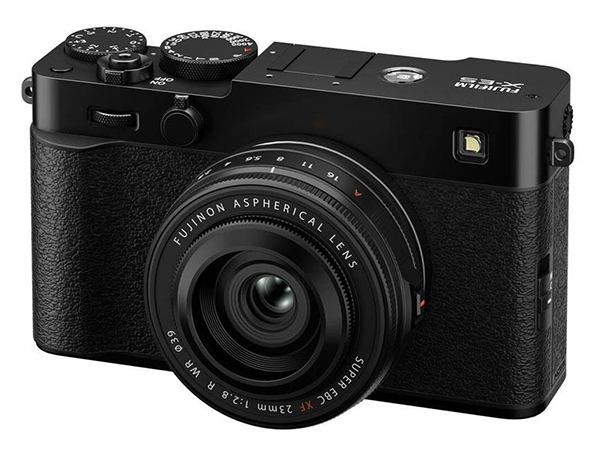
Fujifilm’s X-E5 shares many features with the popular X100VI but accepts interchangeable lenses. It has the same 40-megapixel X-Trans CMOS 4 APS-C (23.5 x 15.6 mm) sensor and X-Processor 5 processor but offers 7-stop IBIS and 8 fps burst shooting, along with 425-point hybrid (CD/PD) autofocusing with human face and eye detection plus recognition of animals, birds, cars, motorcycles, bikes, airplanes and trains. The camera body is made from machined aluminium and has a recessed Film Simulation dial in the top plate for dialling in the 20 Film Simulation modes. The Bluetooth button on the base plate evokes the look of the rewind button on a classic film camera. Wi-Fi and Bluetooth 4.2 connections make it easy to share images and movies through the FUJIFILM XApp or Frame.io Camera to Cloud technology. The tilting 3.2-inch monitor is touch sensitive and has a resolution of 1,040,000 dots.
The 2,360,000-dot EVF and dioptre adjustment lie flush with the body. Users can choose between a Classic display mode with data along the bottom of the frame or a Surround View that shows an additional translucent area outside of the image frame. Continuous shooting is available in both burst and pre-shot modes at up to 20 fps with a 1.29x frame crop. The camera can record 6.2K (16:9) video at up to 30 fps or DCI 4K (17:9) or 4K (16:9) video at up to 60 fps. Full HD video can be recorded at up to 240 fps in High-Speed Rec. mode. Time-lapse recording is also available. The X-E5 provides a wide range of special effects and dynamic range settings. The single SD card slot is UHS-II SD compatible and the rechargeable battery has a capacity of 305 frames/charge. The X-E5 weighs 445 grams and measures 125 x 73 x 39 mm. Its RRP is $2699 and it is offered in kit format with the Fujinon XF 23mm f/2.8 R WR pancake lens (which weighs only 90 grams) for $2999.
Nikon Z30 (June 2022)

Created mainly for vloggers, Nikon’s Z30 camera has a 21-megapixel APS-C (23.6 x 15.8 mm) CMOS sensor that lacks an anti-aliasing filter and sensor-shift stabilisation. It also sports a front-facing vari-angle touch-screen 3-inch monitor but no viewfinder. The screen is used for both framing and adjusting controls. The mode dial carries the basic Auto, P, A, S and M settings plus three customisable User modes. A Self-portrait mode is included for recording selfies. The AF system has 209 selectable points and automatic people and animal recognition and tracking. Focus shift shooting is also available.
4K video can be recorded at up to 30 fps while HD (1280 x 720) recording can be set between 24 fps and 120 fps. The menu includes a Flat Picture Control but Log recording isn’t available. Two large stereo microphone arrays are located on the top panel. External microphones can be fitted to the hot shoe, but there’s no headphone port and the wind filter is an optional extra. SnapBridge is built-into the Z30, along with Wi-Fi and Bluetooth 4.2, allowing basic image sharing and remote control of the camera. The EN-EL25 battery is rated for up to 330 frames/charge and supports USB Power Delivery for charging. The Z30 weighs 405 grams and measures 128 x 74 x 60 mm. It is only offered in kit format with the RRP for the camera body plus X DX 16-50mm f/3.5-6.3 VR lens at $1549 and the Z30 plus Z DX 12-28mm f/3.5-5.6 PZ VR lens at $1699.
Nikon Z50 II (November 2024)
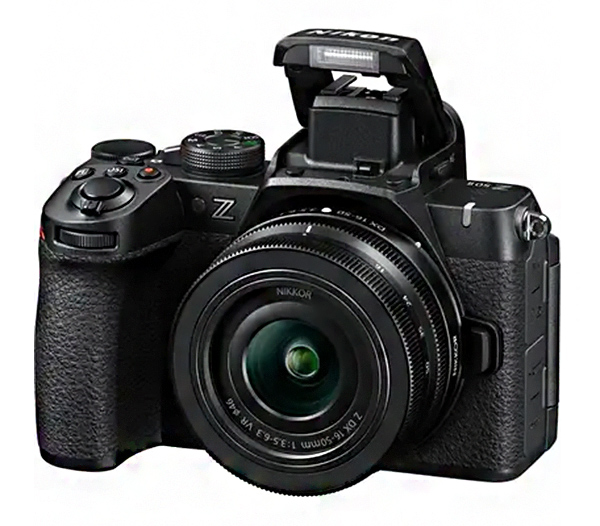
A small step up from the entry level, Nikon’s Z50 II has a 21-megapixel APS-C (23.6 x 15.8 mm) CMOS sensor without sensor-shift stabilisation and uses the older Expeed 7 image processor. Its Hybrid CD/PD AF system includes recognition and tracking for nine subject types and the camera can also perform 30 fps pre-release capture with JPEG files. It has a generous grip, two top-plate control dials and plenty of customisable buttons. NEF 14-bit Raw support is provided along with the ability to record 10-bit HEIF format images. The single SD card slot is UHS-II compliant and the EN-EL25a battery has a capacity of 250 frames/charge.
The fully-articulated 3.2-inch monitor has a resolution of 1,040,000 dots and is touch enabled. The Z50 II also has an EVF with 2,360,000 dots and a magnification of 1.02x. Continuous shooting is supported at up to 11 fps in burst mode and users can record 4K video at up to 30fps. The camera provides Log and HLG video recording modes and includes a waveform monitor for exposure checking. The camera comes with microphone and headphone ports as well as built-in Wi-Fi and Bluetooth 5.0 connections. It weighs 550 grams and measures 127 x 97 x 67 mm and has a RRP of $1599 for the body alone. It is also available with the Nikkor Z DX 16-50mm f/3.5-6.3 VR kit lens for $1849 or the Nikkor Z DX 18-140mm f/3.5-6.3 VR lens for $2279.
OM System OM-5 II (June 2025)
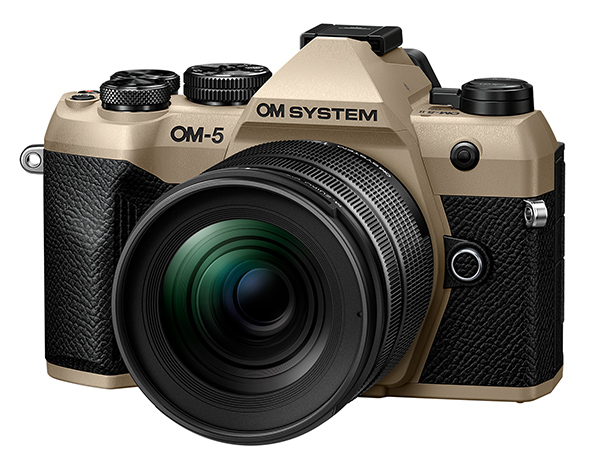
The second-generation OM-5 II has a 20-megapixel M4/3 (17.3 x 13.0 mm) CMOS sensor and TruePix IX processor plus class-leading in-body 5-axis sync IS with 7.5 stops of shake correction. It also boasts a magnesium-alloy body with glass-reinforced polycarbonate cladding and IP53-rated weather sealing. The built-in EVF has a resolution of 2,360,000 dots and the fully-articulated 3-inch LCD monitor has 1,040,000 dots and is touch-screen enabled. A new CP button provides one-touch access to ‘computational’ functions like Live ND, Live GND, High Res Shot, HDR, Focus Stacking and multiple exposure modes. The OM-5 Mark II also provides 22 Scene Modes, which automatically adjust exposure parameters to suit the chosen scene.
Continuous shooting is available at up to 30 fps and the camera can also record both Cinema 4K (4096 x 2160) and UHD 4K (3840 x 2160) video at up to 30 fps. OM-Cinema1 and OM-Cinema2 modes let users apply a ‘cinematic flavour’ to footage. Vertical video recording is supported and the camera can be used as a webcam via its USB-C interface, without requiring extra software. Its single SD media slot is UHS-II compatible, while built-in Wi-Fi and Bluetooth connectivity make it easy to control the camera remotely, geotag images or share files via the OI.Share app. The OM5 II weighs 414 grams and measures 125 x 85 x 50 mm. The RRP for the body alone is $1699 or the camera may be purchased as a kit with the 12-45mm f/4 PRO lens for $2199 or the 14-150mm f/4-5.6 II lens for $2099.
OM-D E-M10 Mark IV (August 2020)

The older E-M10 has the same 20-megapixel M4/3 (17.3 x 13.0 mm) CMOS sensor as the original OM-5 but it’s paired with an older TruePic VIII processor. It also offers only 4.5 stops of sensor-shift shake correction and has a 121-point AF system based upon contrast detection, which includes the ability to detect and track faces. The mode dial carries the basic Auto, P, A, S and M settings plus settings for accessing movie recording, Art Filters, an AP (Advanced Photo) mode and a Scene mode. Left of the EVF is another dial for accessing the Live Control or Super Control Panel as well as a red movie recording button and one to access the 2x ‘digital teleconverter’. There are also two customisable function buttons.
The camera has metal front and top plates and the dials are also metal – but there appears to be no special weather sealing. The tilting 3-inch LCD screen has a resolution of 1,040,000 dots, while the EVF has 2,360,000 dots and offers 1.23x magnification. The E-M10 IV’s pop-up flash has a range of 7.2 metres at ISO 200 (the default) and the hot shoe accepts external flash guns. The top movie resolution is 4K at 30 fps. Continuous shooting is available at up to 8.7 fps. The E-M10 IV’s body measures 122 x 84 x 49 mm and weighs 360 grams with battery and single UHS-II SD card. The RRP for the camera body is $949. It is also offered as a kit with the 14-42mm f/3.5-5.6 EZ lens for $1099.
Panasonic Lumix DC-G97 (December 2024)

Likely using the same 20-megapixel M4/3 (17.3 x 13.0 mm) CMOS sensor with no low-pass filter as the OM System cameras, the Panasonic G97 has a Venus Engine processor and offers 5-axis Dual I.S. stabilisation 2 with five stops of sensor-shift shake correction. Contrast-based autofocusing uses DFD (Depth From Defocus) technology, which scans the scene at 240 fps to claim a lock-on speed of 0.07 second. The fully-articulated 3-inch screen has a resolution of 1,840,000 dots and is touch enabled, while the OLED EVF has a resolution of 2,360,000 dots and 1.48x magnification. The built-in flash has a GN of 6.4 (m/ISO 100). Continuous shooting is supported at up to 9 fps.
4K video can be recorded at up to 30 fps with no time limit and the camera includes a pre-installed V-Log L function. Slow and Quick recording modes are also available. The single SD card slot is UHS-II compatible, while the battery capacity is 290 frames/charge. The battery accepts USB charging. Built-in Wi-Fi and Bluetooth 5.0 make it easy to share images and movies and control the camera from a smart device. The G97 measures 130 x 94 x 77 mm and weighs 530 g with battery and card. The RRP for the camera body with the Lumix G 12-60mm f/3.5-5.6 ASPH. / POWER O.I.S. lens is $1599.
Panasonic Lumix G100D (June 2020)
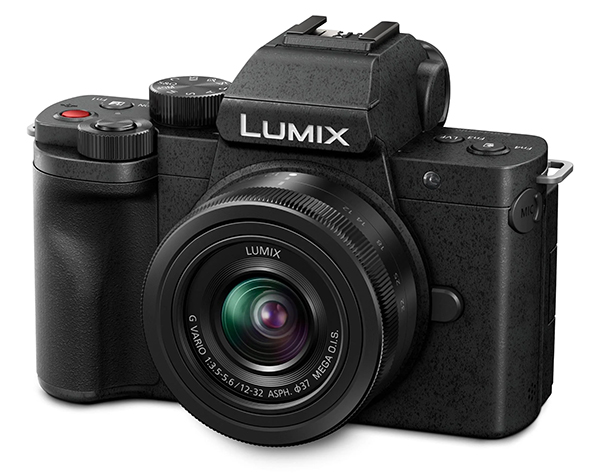
Also featuring a 20-megapixel M4/3 (17.3 x 13.0 mm) CMOS sensor, the G100D is smaller and lighter than the G97, with a weight of 352 grams and measuring 116 x 83 x 54 mm. Images and movies are recorded to a single UHS-I SD card and the BLG10 battery has a capacity of 270 frames/charge and supports USB charging via the USB Type-C connection. The G100D includes Panasonic’s 4K PHOTO modes, with Burst, Stop/Start (S/S) and Pre-Burst settings. It has an articulated 3-inch monitor with static touch control and a resolution of 1,840,000 dots plus an OLED Live View EVF with 2,360,000 dots and 1.48x magnification, which makes it more useful for photographers.
4K video can be recorded at up to 30 fps and the pre-installed V-Log L function allows colour grading in post-production. Time-lapse recording is available. The built-in microphone can automatically adjust the recording range and direction for optimal results. A Video Selfie Mode keeps the user’s face and the background in focus. Full HD movies can be recorded at up to 60 fps with up to 4x slow motion and 8x quick motion settings available.
Vertical video recording is supported and the G100D includes a REC frame indicator and frame marker to assist with framing and cropping. A 3.5mm diameter jack accepts an external microphone. Wi-Fi and Bluetooth make it easy to share movies and images via a smartphone. The RRP for the G100D plus 12-23mm f/3.5-5.6 kit lens is $1299.
Panasonic Lumix DC-S9 (May 2024)

Available in a range of colours, the S9 is designed primarily for vloggers and has no viewfinder. It comes with a new LUMIX Lab app that lets users share images within less than 30 seconds. It boasts a 24-megapixel full frame BSI-CMOS sensor and Venus Engine processor, electronic shutter and IBIS that offers 5 stops of shake correction or 6.5 stops with Dual IS 2 compatible lenses. The S9 has a 3-inch vari-angle LCD with static touch control and a resolution of 1,840,000 dots. The Phase Hybrid autofocus system works for stills and movies and includes detection and tracking of humans, animals, cars, motorcycles, trains and airplanes. Photo Style settings include Cinelike D2, Cinelike V2, Like709 and V-Log and a REAL TIME LUT function that enables users to apply cinematic looks directly in-camera.
The S9 supports 4K/6K video recording and introduces a new recording format; MP4 Lite, which sets the optimum format for smartphone sharing. Vertical video can be recorded and Open Gate shooting provides flexible framing that lets users easily resize aspect ratios to suit social media with the LUMIX Lab app. Stop-motion animation and time-lapse recording are available, along with a Red REC frame indicator, 31-step Master pedestal level, Wave form monitor and Anamorphic desqueeze display settings. The single SD card slot is UHS-II compatible. Continuous shooting of stills is supported at up to 30 fps and the battery capacity is up to 470 frames/charge. The battery also supports USB charging. An external microphone port is provided but no headphones connector. The camera body weighs 486 grams and measures 126 x 74 x 47 mm. The Lumix DC-S9 is available as a body only for an RRP of $2699 or with the Lumix S 18-40mm f/4.5-6.3 L-Mount kit zoom lens for $3299.
Pentax KF (November 2022)
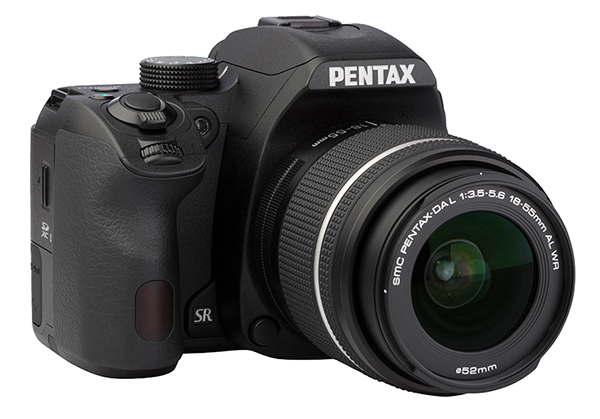
The only DSLR in this round-up, the Pentax KF is a mid-range model with a 24-megapixel APS-C (23.5 x 15.6 mm) CMOS sensor, PRIME MII processor and Accelerator chip plus adjustable AA filter simulator. It has a straightforward user interface and a weather-resistant body that resists temperatures down to -10 degrees C and includes 4.5-stop sensor-shift stabilisation that works with all lenses. The KF can record stills as JPEGs or raw files in DNG or PEF format but is limited to FHD video at 60 fps. Its SAFOX X hybrid CD/PD autofocusing system supports face detection and tracking. The vari-angle LCD has 1,037,000 dots and, like other DSLRs, the KF has a bright optical viewfinder with 0.95x magnification. It also comes with a built-in GN 12 flash.
The KF boasts an array of interval shooting capabilities, along with pixel-shift multi-exposures for motion correction. Its top shutter speed is 1/6000 second and continuous shooting is supported at up to 6 fps. Data is recorded to a single USH-I SD card slot, the D-LI109 battery has a capacity of 410 shots/charge. The camera has a microphone port – but no headphone connection. Built-in Wi-Fi allows users to check the Live View image, adjust a variety of camera functions, and download images to a mobile device via the dedicated Sync app. The camera body is offered in black, with crystal blue and crystal white versions also available. It weighs 688 grams and measures 126 x 93 x 74 mm and the basic black version body has a local RRP of $1299. It is also sold with the SMC DA 18-135mm f/3.5-5.6 ED AL (IF) DC WR kit lens for an RRP of $1499.
Sony ZV-E10 II (July 2024)

Sony’s second-generation, rangefinder-style vlogging camera features a new 26-megapixel APS-C (23 x 15.5 mm) Exmor R BSI-CMOS sensor and the latest BIONZ XR image processor, which has up to eight times more real-time processing power than the previous model’s chip. There is no viewfinder; only a vari-angle 3-inch touch screen LCD with 1,036,800 dots. The ZV-E10 II can record 4K video at up to 60 fps with 10-bit quality and includes a Cinematic Vlog Setting with special ‘Looks’ such as S-Cinetone that can enhance skin tones, “Moods” that can emphasise specific colours, and adjustable AF transition speed that determines how quickly the focus will switch between subjects. Vertical format recording is supported, along with up to 5x slow motion video and time-lapse recording.
The 759-point hybrid CD/PD autofocusing system includes the latest subject-recognition algorithms, while Face Priority AE optimises exposures. A Soft Skin Effect suppresses wrinkles and blemishes. Active Mode electronic image stabilisation employs a gyroscope and advanced algorithm to measure and compensate for camera shake during video recordings, while slightly cropping the frame. The ‘intelligent’ 3-capsule microphone can capture clear, high-quality audio and the camera is supplied with a wind filter that attaches to the hoe shoe. Continuous shooting is supported at up to11 fps with live streaming via Wi-Fi and the Creators’ Cloud platform. The camera has a single UHS-II SD media slot plus microphone and headphone ports. Its NP-FZ100 battery can support up to 195 minutes of recording per charge. The camera body is available in black or white. It weighs 377 grams and measures 121 x 68 x 54 mm and has a RRP of $1599. It is also offered with the E PZ 16-50mm f/3.5-5.6 OSS II kit lens for $1699.
Sony FX2 (May 2025)

Sony’s latest Cinema Line camera, the FX2, sports a 33-megapixel full frame Exmor R BSI-CMOS sensor and BIONZ XR processor. Weighing 679 grams and measuring 130 x 104 x 78 mm, it is ideal for handheld shooting as well as gimbal and drone mounting. Built-in 5-axis SteadyShot stabilisation offers up to 5.5 stops of camera shake correction with additional electronic stabilisation available in the Dynamic active Mode. A single switch selects between MOVIE or STILL mode and stills can be recorded in JPEG, HEIF or ARW.RAW format with a maximum image size of 7008 x 4672 pixels. It can record XAVC HS 4K video at up to 60 fps or Full HD video at up to 120 fps and includes slow and quick recording modes, proxy recording, time coding and raw video output. Three modes are available for Log recording: Flexible ISO, Cine EI, and Cine EI Quick. The Fast Hybrid CD/PD AF system has 759 PD points and includes human, animal, bird, insect, car, train and airplane recognition and tracking. An Auto Framing function automatically crops and tracks a subject to keep them centred.
The camera has dual media slots for SD UHS 1/11 and CFexpress Type A cards. Users can stream up to 4K 60p video via LAN while simultaneously recording to a card. The S-Log3 gamma curve is available for both video and stills. The built-in tiltable EVF has a resolution of 3,686,400 dots and 0.7x magnification with its angle of view and eyepoint optimised for video recording. The fully-articulated touch-screen LCD has 1,036,800 dots. Continuous shooting is supported at up to 10 fps. Heat build-up is prevented through an internal cooling fan and thermally-conductive graphite in the camera’s construction. Microphone and headphone terminals are provided and the camera has both Wi-Fi and Bluetooth interfaces. The magnesium alloy body has fittings for mounting accessories like the optional Handle Unit XLR-H1 that accepts two XLR connectors and a digital audio interface without needing extra batteries or cables. Sony’s Monitor & Control app enables remote control and image monitoring on a smartphone or tablet screen and also provides waveform and other displays for exposure and focus confirmation. The Catalyst Browse and Catalyst Prepare apps let users edit video recorded in Log mode with embedded LUTs, while Cloud Upload supports direct upload to Creators’ Cloud storage. The local RRP is $5299 or $5999 with the XLR handle. The camera can be paired with the PZ 16-35mm f/4 G lens (RRP $1199), the FE 24-50mm f/2.8 G lens (RRP $1399) or the FE 24-70 f/2.8 GM II lens (RRP $2699).
See Photo Review’s Compact camera buying guide
Photo Review Retail Partners

